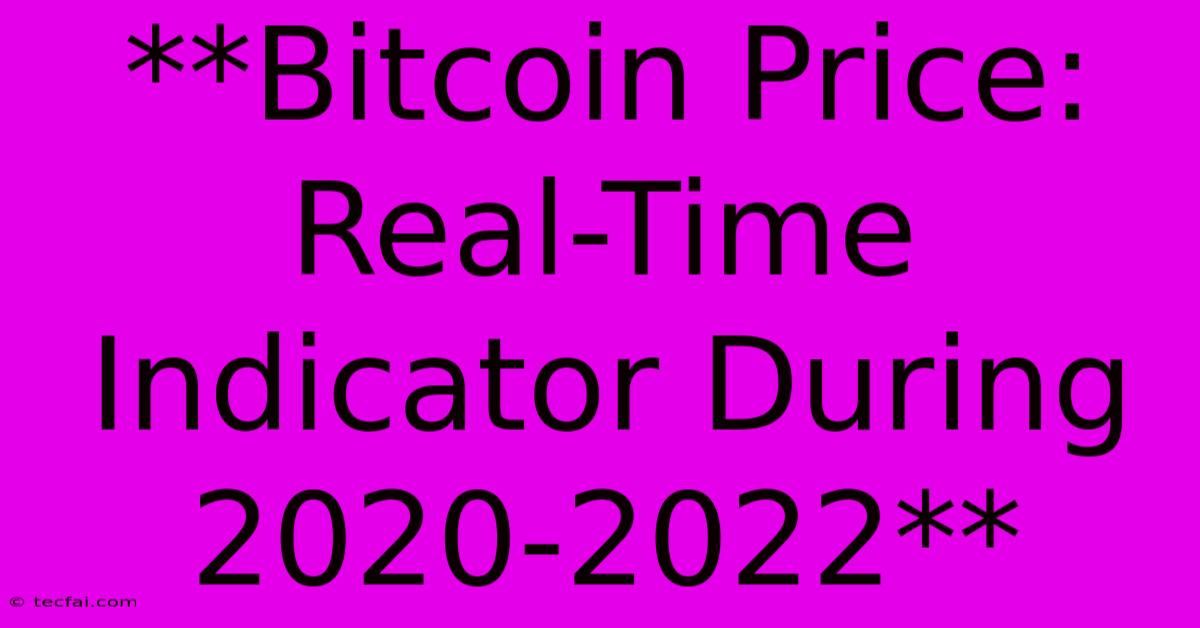**Bitcoin Price: Real-Time Indicator During 2020-2022**

Discover more detailed and exciting information on our website. Click the link below to start your adventure: Visit Best Website tecfai.com. Don't miss out!
Table of Contents
Bitcoin Price: Real-Time Indicator During 2020-2022
The period between 2020 and 2022 witnessed a rollercoaster ride for Bitcoin, the leading cryptocurrency. While its price fluctuated dramatically, it served as a real-time indicator of various global economic and political events, showcasing its sensitivity to market sentiment and external factors.
2020: A Year of Resilience and Growth
The year 2020 began with Bitcoin trading around $7,000. The global pandemic, coupled with economic uncertainty, initially pushed its price down, but it quickly rebounded, reaching a new all-time high above $29,000 by the end of the year. This surge was fueled by:
- Increased Institutional Interest: Traditional financial institutions and investors began showing growing interest in Bitcoin, seeing it as a hedge against inflation and a potential diversification tool.
- Growing Adoption: More businesses and individuals embraced Bitcoin as a payment method, contributing to its adoption and value.
- Government Stimulus: Governments worldwide implemented economic stimulus packages, injecting liquidity into the market, which positively impacted Bitcoin's price.
2021: A Bullish Run and Historic Highs
2021 was a year of unprecedented growth for Bitcoin. It continued its upward trajectory, reaching a new all-time high above $64,000 in April. Key drivers of this bullish run were:
- Tesla Investment: Electric vehicle giant Tesla invested $1.5 billion in Bitcoin, further legitimizing the cryptocurrency and attracting mainstream attention.
- Growing Institutional Demand: Financial institutions continued to increase their Bitcoin holdings, further pushing the price higher.
- Rising Inflation: Persistent inflation concerns led investors to seek alternative assets like Bitcoin as a hedge against inflation.
2022: A Year of Correction and Volatility
The year 2022 marked a significant correction in Bitcoin's price, dropping to below $20,000 by the end of the year. This decline was attributed to several factors:
- Rising Interest Rates: Central banks around the world aggressively raised interest rates to combat inflation, leading to a shift in investor sentiment towards risk-off assets.
- Macroeconomic Uncertainty: The ongoing war in Ukraine, supply chain disruptions, and rising energy prices created an environment of uncertainty that affected Bitcoin's price.
- Crypto Market Crash: The collapse of TerraUSD and Luna, a stablecoin and its associated cryptocurrency, triggered a broader sell-off in the crypto market, dragging down Bitcoin's price.
Bitcoin as a Real-Time Indicator
The price fluctuations of Bitcoin during 2020-2022 highlighted its ability to act as a real-time indicator of global economic and political events. Its sensitivity to:
- Market Sentiment: Shifts in investor sentiment, driven by news events, economic indicators, and geopolitical tensions, significantly impact Bitcoin's price.
- Macroeconomic Conditions: Factors like interest rate changes, inflation levels, and global economic growth directly influence the demand for Bitcoin.
- Regulatory Developments: Government regulations and policies surrounding cryptocurrency adoption have a substantial effect on Bitcoin's price.
Conclusion
The price of Bitcoin during 2020-2022 demonstrated its dynamic nature, reflecting the global macroeconomic landscape and investor sentiment. While its volatility can be a concern for some, it also serves as a valuable indicator of evolving market dynamics and future trends. As the cryptocurrency market matures, Bitcoin's role as a real-time indicator is likely to remain significant. However, investors should exercise caution and conduct thorough research before making any investment decisions, considering the inherent risks associated with the crypto market.

Thank you for visiting our website wich cover about **Bitcoin Price: Real-Time Indicator During 2020-2022** . We hope the information provided has been useful to you. Feel free to contact us if you have any questions or need further assistance. See you next time and dont miss to bookmark.
Featured Posts
-
Diverse Cybersecurity Teams Improved Threat Response
Nov 07, 2024
-
Luton Town Vs Cardiff City Live Updates
Nov 07, 2024
-
Camilla Updates King Charles Health On Tv
Nov 07, 2024
-
Stock Market News Nov 6 2024 Dow S And P Nasdaq
Nov 07, 2024
-
Tinubu Announces Death Of Army Chief Lagbaja
Nov 07, 2024
